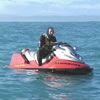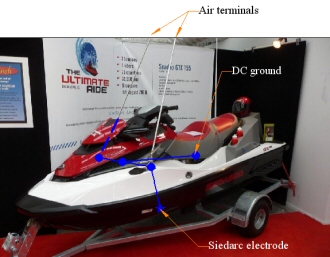Jetski lightning protection system
Vessel: SeaDoo GTX155 jetski
In view of their speed and typical use in local waters, a jetski may appear to be an unlikely candidate for lightning protection. However, given the significant risk of serious injury or death following a strike, for the three riders whose craft have now been outfitted with our system, it was not an option. Organizer and captain Jeremy Burfoot is undertaking a ride by jetski from London to Sydney to raise awareness for cancer. As a sponsor of this project, Marine Lightning Protection has provided the lightning protection systems for all three jetskis. Since their journey takes them through several lightning hotspots in the tropics, an encounter with thunderstorms is a high probablility.
Special hazards
Since the rider's head is the most exposed part of a jetski, the major hazard is that the lightning will attach directly to the rider, possibly causing death, and definitely causing serious injury. Risks of lesser consequence are that the jetski will become incapacitated or sink.
Layout
In spite of the difference between a jetski and a more typical boat, the lightning protections system has similar features to the generic powerboat system:
- air terminals that provide a protective zone over the rider
- multiple grounding terminals
- DC ground bonded to lightning system
In order to place the rider's head in a zone of protection, the tips of the two air terminals are higher and on either side. This provides far superior protection to a single rod. The base of both both air terminals are connected to two SidearcTM electrodes and the DC ground to equalize potentials over the whole boat and provide external paths for the lightning current. Mounting the two air terminals just outboard of the rider and directly above the electrodes provides
enhanced protection and a direct path from the strike point to a grounding terminal.
Air terminals
The two SMAT air terminals have a surface-mount base with both a ratchet for lowering and the capability to be screwed out of the base for stowing during passages in temperate climes. The main challenge in this vessel is to build the support with enough flexibility to prevent damage but not so much that the rod flails around in choppy conditions. The natural frequency of about 2 Hz should be sufficiently higher then that of the jetski to prevent flailing.
Main conductors
The DC ground is connected to both the air terminal connection and the SiedarcTM electrodes.
This equalizes the potentials for electric wiring , control cables, and the engine.
Connectors
Since the main conductor runs right by both air terminals and electrodes, the only additional connection is to the bonding conductor, which is a 3-way splice.
Grounding
Immersed strips
The immersed jet drive is connected to the lightning system via the DC ground conductors.
SiedarcTM electrodes
Two
SiedarcTM electrodes with daisy-chain connectors are placed at the bow directly below the base of the air terminal, just above the waterline when the craft is at rest.
|

